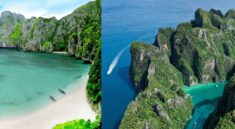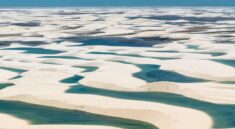Trolltunga, the Troll’s Tongue or Troll’s Rock, is an iconic and mesmerizing natural rock formation nestled in the heart of Norway’s awe-inspiring landscapes. This renowned geological wonder captivates the imagination of adventurers, hikers, and photographers from around the world. With its striking appearance and challenging approach, Trolltunga offers a unique and unforgettable experience.
Trolltunga is situated near the town of Odda in Hordaland County, southwestern Norway. Its name, which translates to “Troll’s Tongue,” perfectly describes its shape. The rock formation appears as a massive horizontal ledge jutting out from the mountain, hovering approximately 700 meters (about 2,300 feet) above the serene waters of Ringedalsvatnet lake. This seemingly gravity-defying natural platform is one of the most iconic and photographed sites in Norway.
Reaching Trolltunga is a journey of both physical and visual splendor. The adventure begins with a demanding hike along a trail that stretches for approximately 27 kilometers (about 17 miles) round trip. Hikers navigate through a landscape that transitions from dense forests to rocky terrain, ascending to higher altitudes that reveal breathtaking panoramas.
The trail winds its way through the captivating Norwegian wilderness, passing by lush greenery in the summer and enchanting snow-covered landscapes in the winter. Along the way, cascading waterfalls, crystal-clear lakes, and dramatic mountain vistas contribute to the allure of the hike. Hikers often pause to marvel at these natural wonders and capture their beauty in photographs.
How to get there
Reaching Trolltunga in Norway involves a journey to the town of Odda, followed by a challenging hike to the iconic rock formation. Here are the steps to get to Trolltunga:
1. Travel to Odda:
- Start by making your way to the town of Odda, located in Hordaland County, southwestern Norway. Odda serves as the gateway to Trolltunga and is the nearest town to the trailhead.
2. Transportation Options to Odda:
- By Car: If you have access to a car, you can drive to Odda. The town is accessible by road, and there are parking facilities available for hikers.
- Public Transportation: You can also reach Odda by using public transportation, including buses and trains. The nearest train station is in Voss, which is connected to major cities like Oslo and Bergen. From Voss, you can take a bus to Odda.
3. Start the Hike:
- The trailhead for the hike to Trolltunga is located at Skjeggedal, which is approximately 7 kilometers (about 4.3 miles) from Odda. You can reach Skjeggedal from Odda by car or taxi.
4. Hiking to Trolltunga:
- The hike to Trolltunga is challenging and covers approximately 27 kilometers (about 17 miles) round trip. It typically takes around 8 to 12 hours to complete, depending on your pace and trail conditions.
- The trail is well-marked, but it involves steep ascents, rocky terrain, and variable weather conditions. Be prepared with suitable clothing, provisions, and safety gear.
- Hiking to Trolltunga is best undertaken during the summer months (June to September) when the weather is milder and the trail is snow-free. However, it’s essential to check trail conditions and weather forecasts before starting your hike.
Things to do
While visiting Trolltunga in Norway, the primary attraction is, of course, the hike to the iconic rock formation. However, there are several other activities and things to do in the area to enhance your experience and make the most of your visit:
- Hike to Trolltunga: The main adventure is, undoubtedly, the challenging hike to Trolltunga. Enjoy the stunning landscapes, waterfalls, and ever-changing terrain as you make your way to the rock formation. Don’t forget to capture breathtaking photos when you reach your destination.
- Photography: Trolltunga is a photographer’s dream. Capture the natural beauty of the landscape, the fjords, and the iconic rock formation itself. The changing seasons provide unique opportunities for stunning shots.
- Picnicking: Pack a picnic and enjoy a meal with a view. Once you reach Trolltunga, it’s a great spot to relax, refuel, and savor the Norwegian wilderness.
- Camping: If you want to experience the wilderness overnight, camping is an option. There are designated camping areas along the trail and near Trolltunga. Be sure to follow Leave No Trace principles and obtain any required permits.
- Stargazing: On clear nights, the remote location of Trolltunga makes it an excellent spot for stargazing. Enjoy the brilliance of the night sky, and if you’re lucky, you might catch a glimpse of the Northern Lights during the winter months.
- Visit Odda: Explore the charming town of Odda before or after your hike. Odda offers quaint streets, shops, restaurants, and a welcoming atmosphere. It’s an ideal place to unwind and reflect on your Trolltunga adventure.
- Explore the Fjords: The Hordaland region is known for its stunning fjords, including the Hardangerfjord. Consider taking a boat tour or cruise to explore the fjords and gain a different perspective of the landscape.
- Water Activities: In the summer, you can engage in various water activities on the lakes and fjords, such as kayaking, canoeing, and paddleboarding.
- Nearby Hikes: If you have more time and energy, there are other notable hikes in the vicinity, such as the hike to Buerbreen Glacier or the Husedalen Valley with its stunning waterfalls.
- Winter Activities: During the winter months, Trolltunga and the surrounding area offer opportunities for snowshoeing and cross-country skiing. Winter hiking to Trolltunga is also an option for those seeking a unique experience.
- Cultural Experiences: Learn about the local culture and history of the area. There may be cultural events, museums, or exhibitions in Odda or nearby towns.
Things not to forget
When embarking on a hike to Trolltunga in Norway, it’s crucial to be well-prepared to ensure your safety and comfort throughout the challenging journey. Here is a list of important items and considerations not to forget:
1. Proper Hiking Gear:
- Sturdy and waterproof hiking boots with ankle support.
- Comfortable moisture-wicking clothing suitable for the season.
- Layered clothing for temperature variations.
- Waterproof and windproof jacket and pants.
- Warm gloves and a hat for cooler weather.
- Sunglasses, sunscreen, and a wide-brimmed hat for sun protection.
- A backpack to carry essentials.
2. Navigation and Safety:
- Detailed trail map and compass or GPS device.
- Fully charged mobile phone with a power bank.
- A whistle and a basic first-aid kit.
- Headlamp or flashlight with extra batteries.
- Personal identification and emergency contact information.
3. Food and Water:
- Sufficient water for the entire hike (at least 2-3 liters per person).
- High-energy snacks and trail mix.
- Packed lunch or picnic food if desired.
4. Shelter and Comfort:
- Emergency space blanket or bivvy.
- Lightweight trekking poles for stability.
- Insect repellent (during summer months).
5. Navigation and Planning:
- Detailed map of the Trolltunga trail and the surrounding area.
- Knowledge of the trail and its conditions (check local information).
- Awareness of weather forecasts and trail conditions (check before and during your hike).
6. Permits and Regulations:
- Check if permits are required for camping or parking at trailheads (if applicable).
- Adhere to Leave No Trace principles to minimize your environmental impact.
7. Safety and Communication:
- Share your hiking plans and expected return time with someone.
- Ensure your mobile phone is fully charged and in airplane mode to conserve battery.
- Familiarize yourself with emergency procedures and contact numbers.
8. Clothing Considerations:
- Dress in layers to accommodate changing weather conditions.
- Wear moisture-wicking and breathable fabrics to stay dry and comfortable.
- Choose clothing appropriate for the season, whether it’s summer or winter.
9. Waste Management:
- Bring trash bags to pack out all your waste, including food wrappers and used tissue.
10. Leave No Trace: – Follow Leave No Trace principles by respecting the environment, staying on marked trails, and not disturbing wildlife or plants.
11. Check Trail Conditions: – Before setting out, inquire about the current trail conditions and any closures or restrictions.
12. Cash and Essentials: – Carry some cash, identification, and any essential travel documents in a waterproof pouch.
Best time to visit
The best time to visit Trolltunga in Norway depends on your preferences and what kind of experience you’re seeking. Here are the key factors to consider for each season:
1. Summer (June to August):
- Pros: Summer is the most popular time to visit Trolltunga. The weather is generally mild, with temperatures ranging from 10°C to 20°C (50°F to 68°F) in the daytime.
- Pros: The trail is mostly free of snow, and the landscape is lush and vibrant with greenery. You’ll enjoy longer daylight hours for hiking.
- Cons: Summer can be crowded, so expect more fellow hikers on the trail and at the Trolltunga viewpoint. Accommodations and parking may fill up quickly, so it’s essential to book in advance.
2. Fall (September to October):
- Pros: Fall offers cooler temperatures and fewer crowds compared to summer. The autumn foliage creates a colorful backdrop for your hike.
- Cons: Be prepared for variable weather, including rain and cooler temperatures. The days are shorter, so plan your hike accordingly.
3. Winter (December to March):
- Pros: If you’re looking for a unique and serene experience, consider hiking to Trolltunga in the winter. The landscape is transformed into a winter wonderland with snow-covered trails and frozen lakes.
- Cons: Winter hiking is challenging and requires specialized gear, including crampons, ice axes, and appropriate clothing. The trail can be icy and slippery, and daylight hours are limited.
4. Spring (April to May):
- Pros: Spring brings milder temperatures and longer days compared to winter. The trail starts to thaw, making it more accessible for hiking.
- Cons: Similar to fall, spring can be unpredictable in terms of weather. There may still be snow on the trail, especially at higher elevations.
How long does it take to climb Trolltunga?
The time it takes to climb Trolltunga depends on several factors, including your hiking speed, physical fitness, trail conditions, and the season you choose to hike. On average, hikers can expect the following approximate hiking times:
- Summer (June to August):
- In the summer months, when the trail is mostly clear of snow and ice, the round-trip hike to Trolltunga typically takes around 8 to 12 hours.
- This duration includes the hike itself, time spent at Trolltunga for photos and enjoyment, and rest breaks along the way.
- Fall (September to October):
- During the fall, when the weather is cooler and there are fewer crowds, the hike can take a similar amount of time as in summer, approximately 8 to 12 hours.
- Winter (December to March):
- Hiking to Trolltunga in the winter can be more challenging due to snow and ice on the trail. This season may require additional time.
- Winter hikes to Trolltunga can take anywhere from 10 to 14 hours or more, depending on the conditions and your experience with winter hiking.
- Be prepared for shorter daylight hours during the winter.
- Spring (April to May):
- In the spring, the trail starts to thaw, and conditions can be variable. Hiking times can range from 8 to 12 hours or more, similar to fall and summer.
Keep in mind that these are approximate times, and individual hiking speeds vary. It’s essential to plan for enough time to complete the hike safely and comfortably. Factors such as rest breaks, weather-related delays, and your physical fitness will affect the overall duration of your hike.
Additionally, consider starting your hike early in the day, regardless of the season, to allow for ample daylight and to avoid hiking in the dark. Proper planning, adequate clothing, and essential supplies are crucial to ensure a successful and enjoyable hike to Trolltunga.
Is Trolltunga a hard hike?
Yes, Trolltunga is considered a challenging and demanding hike. Several factors contribute to its level of difficulty:
- Length: The round-trip hike to Trolltunga covers approximately 27 kilometers (about 17 miles), making it a long-distance hike. The length alone can be physically demanding.
- Elevation Gain: The trail involves a significant elevation gain, with steep ascents and descents. Hikers encounter rugged and rocky terrain, including sections with loose gravel and boulders.
- Variable Weather: The weather in the Trolltunga area can change rapidly, even during the summer months. Hikers may encounter rain, snow, wind, and temperature fluctuations, which can add to the challenge and require proper gear and clothing.
- Trail Conditions: The condition of the trail can vary depending on the season. In summer, it is mostly clear of snow and ice, but it can be rocky and slippery. In winter and spring, the trail may be covered in snow and ice, requiring additional equipment like crampons and ice axes.
- Physical Fitness: Hiking to Trolltunga requires a good level of physical fitness. Hikers should be prepared for long hours of walking and steep ascents and descents. Training and preparation are advisable before attempting the hike.
- Duration: Depending on your hiking speed and the season, the hike can take anywhere from 8 to 14 hours or more, including rest breaks and time spent at Trolltunga itself.
- Safety Precautions: Hikers need to take safety precautions seriously, including checking the weather forecast, carrying essential gear and supplies, and knowing the trail and its conditions. It’s crucial to be prepared for emergencies.
Can you hike Trolltunga alone?
Hiking Trolltunga alone is possible, but it comes with its own set of considerations and potential challenges. Here are some important factors to keep in mind if you’re considering hiking Trolltunga solo:
1. Physical Fitness: Ensure that you are physically fit and prepared for a demanding hike. Trolltunga is a challenging trek, and being in good shape is essential for completing it safely, whether you’re alone or with a group.
2. Experience: If you have prior hiking and outdoor experience, including navigating trails and handling various weather conditions, you may be better equipped to hike alone. Novice hikers should consider going with a group or guide.
3. Navigation Skills: It’s crucial to have basic navigation skills and be familiar with the trail map, especially if you plan to hike solo. A GPS device or smartphone with a reliable map app can be helpful.
4. Inform Others: Before setting out, inform someone you trust about your hiking plans, including your expected starting and ending times. Provide them with your itinerary, contact information, and emergency procedures. Check in with them upon your return.
5. Safety Gear: Carry the necessary safety gear, including a first-aid kit, headlamp, extra clothing, food, water, and an emergency space blanket. Be prepared for changing weather conditions.
6. Weather Forecast: Check the weather forecast and trail conditions before starting your hike. Be prepared to turn back if the weather deteriorates or if conditions become unsafe.
7. Daylight Hours: Consider the time of year and the available daylight hours. Starting your hike early in the day is advisable to ensure you have enough time to complete the hike before dark.
8. Experience Crowds: If you hike during the peak season (summer), Trolltunga can be crowded, and you may encounter other hikers along the trail. If you prefer solitude, consider hiking during the shoulder seasons (fall or spring) or in winter.
9. Winter Hiking: If you plan to hike Trolltunga in winter, be aware that it’s more challenging due to snow and ice. Winter hiking requires specialized equipment and skills. It may not be recommended for solo hikers without prior winter hiking experience.
10. Group or Guide: If you have concerns about hiking alone or lack experience, consider joining a guided tour or hiking with a group. This can provide additional safety and support.
Why is Trolltunga called Trolltunga?
Trolltunga, which translates to “Troll’s Tongue” in English, is named after its unique and distinctive rock formation that resembles a protruding tongue. The name “Trolltunga” reflects the folklore and mythology of the region, as trolls are legendary creatures in Norwegian folklore.
In Norse mythology, trolls are often depicted as supernatural beings or creatures of folklore that dwell in the mountains, forests, and remote areas of Norway. They are known for their size, strength, and sometimes mischievous or malevolent behavior.
The naming of Trolltunga reflects the imaginative and whimsical nature of folklore, as the rock formation’s shape and location high in the mountains evoke the idea of a troll’s tongue sticking out from the cliff’s edge. The name adds to the mystique and allure of the site, making it a popular destination for hikers and tourists who are drawn to its natural beauty and the opportunity to capture memorable photographs on this iconic “tongue” of rock.
Image credits: trolltunga.com





